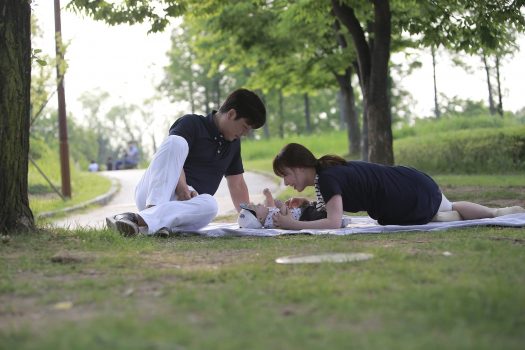By Juliann Woods, Ph.D., CCC-SLP
More than ever, research indicates the incredible role of families in their children’s communication development. We are learning more and more about early brain development and how parents and other caregivers can contribute to the social, emotional and communication development of babies from day one. In fact, some of what we are learning may be counter to the way we were raised or the way our extended family believes is most appropriate. For example, did you know parents are now encouraged to engage in multiple forms of appropriate physical touch to foster social connectedness and security for babies? These forms of touch are not just brief hugs before and after naps, or during distress, but any time and every time the baby is interested! Zero to Three provides a great overview of this information in this video.
Babies typically share eye contact with adults as early as 6-8 weeks which helps to build attachment and social communication [1]. When adults and babies look directly at each other, babies try to communicate more often. When adults respond with a word or action, babies can try again and take another turn. [2]
These simple exchanges are the beginning of conversations – the back-and-forth interactions that build a child’s participation with a communication partner. When you pair quality back-and-forth interactions with hearing and repeating meaningful words, it creates a win-win situation for the child’s social communication learning! This video from the Hanen Centre further discusses the importance of these types of interaction.
What else do parents need to know to promote early communication and language development when they are concerned about their child or he/she has a disability or developmental delays? Often, they need to be aware of ways to make the most of their everyday routines and activities to provide additional attention, use special strategies, or provide more opportunities for their child to practice and learn communication skills. Because of the importance of the relationship between the parent and child, we know that parents can be terrific communication partners for their child. They may, however, need information and coaching from an early intervention professional to learn strategies that will help them engage their child in conversations and social interaction to teach communication and language skills. The good news is that it does not have to take extra time and energy, special toys, or expensive materials to support a child’s development in this way. Military family members experiencing a separation due to deployment, can still participate in ways that are meaningful, enjoyable, and facilitate early communication and language development!
[1] Erhard-Weiss, D., Meltzoff, A. N., & Brooks, R. (2007). Eyes wide shut: The importance of eyes in infant gaze following and understanding other minds. In R. Flom, K. Lee, & D. Muir (Eds.), Gaze following: Its development and significance (pp. 217-241). Mahwah, NJ: Erlbaum.
[2] Parlakian, R. (2016). It takes two: The roots of language learning. Retrieved from http://www.pbs.org/parents/expert-tips-advice/2016/02/takes-two-roots-language-learning/
Image from Pixabay.com, CC0















